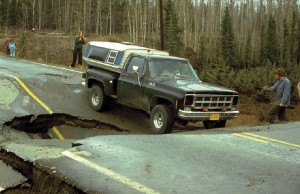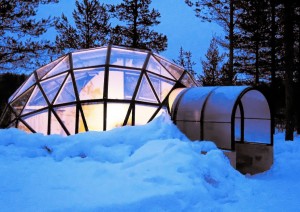A Northern engineer once wrote that if you want to build a house in the Arctic, place a window overlooking every direction from which a bear might come and a door on the opposite side. Architecture, due to the immovable nature of its products, should be one of the most locally-attuned disciplines in the professional world. A glance around Fairbanks and Anchorage, however, turns up Ranch-style homes with sliding glass patio walls, New England salt box houses and even colonnaded Southern Colonial mansions.
A change in this thinking becomes pressing long before our energy use is forced to drop — climate change is already melting the permafrost that underlies many of the existing structures — especially those in the taiga where it only takes a couple of degrees to tip the balance toward melting ground.
Though cold-climate innovation centres exist, trying to adapt Southern technologies to Northern realities, the post-hydrocarbon future of inhospitable territories may rely just as much on reviving old technologies, summarily dismissed by the latest wave of settlers, as it does on new ideas.
 Some simple principles can be reclaimed from a form of housing recently jettisoned by nomadic people when they settled around trading posts and dug their heels in for the long haul. The igloo was only ever popular in a small span of Canadian Arctic archipelago – never seen in traditional Alaskan or Greenlandic societies, for instance – but it includes a lot of the design concepts lost in later housing construction.
Some simple principles can be reclaimed from a form of housing recently jettisoned by nomadic people when they settled around trading posts and dug their heels in for the long haul. The igloo was only ever popular in a small span of Canadian Arctic archipelago – never seen in traditional Alaskan or Greenlandic societies, for instance – but it includes a lot of the design concepts lost in later housing construction.
A hemisphere is the perfect shape, not only for the structural integrity of the light snow that comprises it, but also to minimize surface-to-volume ratios and, consequently, heat loss. Entrance to an igloo – oriented away from direct wind and side-on to possible snow drifts – is through a dipping passageway called a cold trap. This allows for comings and goings without changing the climate inside.
Airplane design used to accommodate this phenomenon. Whereas the current Boeing 737 design has crew bundling up in winter clothing to open a side door for passengers to board, the old 727 was entered from a door in the floor, allowing the plane to stay open without heat loss or crew discomfort.
Passive refrigeration — where instead of putting an electric freezer inside a heated room, food and drinks are exposed, to varying degrees, to the elements in cold climates — is taken to another level in an igloo. The basement level, also known as the quarry from which the walls and benches were excavated, is used as a deep freeze not only for food but for waste that normally would stink up the place.
Northern businesses like large liquor stores, which normally refrigerate vast rooms, are slowly catching on to this notion of harnessing the elements. It would have been intuitively obvious if the modern modes of operating weren’t so deeply ingrained in us all.

3 thoughts on “An Abstemious Home”
Comments are closed.